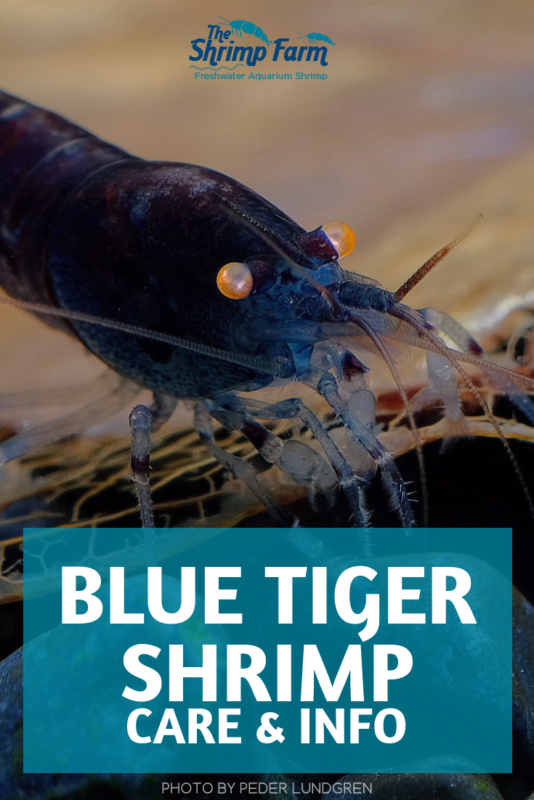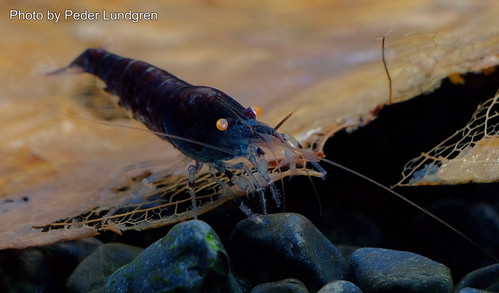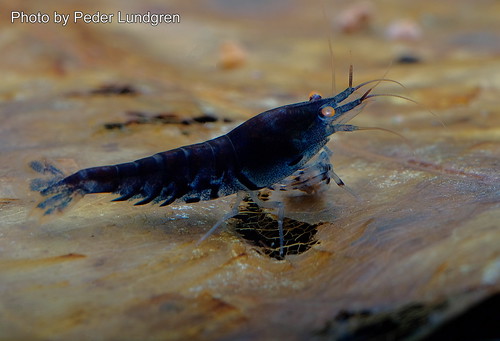Blue tiger shrimp (Caridina mariae 'Blue Tiger')
Blue tiger shrimp (Caridina mariae 'Blue Tiger') are a stunning selectively bred aquarium shrimp species. Also known as Orange Eyed Blue Tiger shrimp, their name says it all: these shrimp are bright blue with black stripes and striking orange eyes. Their looks alone are probably enough to make anyone want to start a colony!
Keep reading for everything you need to know about Blue Tiger shrimp care and keeping these stunning dwarf shrimp in your home aquarium.
| Scientific name | Caridina mariae 'Blue Tiger' (formerly Caridina cf. cantonensis 'Blue Tiger') |
| Common names | Blue tiger shrimp, Orange Eyed Blue Tiger shrimp, OEBT |
| Difficulty level | Moderate |
| Origin | Southeast Asia |

Table of Contents
Setting up a Blue Tiger shrimp aquarium
OEBT requirements
Blue Tiger shrimp requirements are similar to those of other Tiger shrimp varieties, like the Red Tiger shrimp. Any tank that is large enough to hold a stable cycle should make a good home for a Blue Tiger colony. Bigger is better when it comes to aquariums, though, as these shrimp can be a little fussy about water values and a larger tank is much easier to keep stable than a small one.
A 10 gallon (38L) aquarium is a good starting point for a beginner. More experienced aquarists might also consider a 5 gallon (19L).
All shrimp need a filtered, fully cycled aquarium. Filter-wise, go for something that isn't too strong and won't suck up baby shrimp. A sponge filter or any normal filter with an intake cover should work. If you're not entirely sure why a filter is needed and what cycling an aquarium means, be sure to have a look at this page before attempting to keep any shrimp. A heater to prevent sudden fluctuations in water temperature is also a good idea.
As paradoxical as it might sound, shrimp that have very few places to hide will usually spend more of their time attempting to hide than shrimp that have access to plenty of cover. If you want your Tigers to display their normal behaviors, offer at least some hiding places. Live plants work well for this.
OEBT water quality
Water quality is one of the most important care aspects for all shrimp. Blue Tiger shrimp aren't the easiest and can be a little fragile due to inbreeding, so be sure to stay on top of your water values and check them regularly. Soft, acidic water works best for this species.
Never introduce any shrimp, including Tiger shrimp, into an uncycled aquarium. Ammonia and nitrite can wipe out your colony in a matter of hours! Also be sure to perform regular water changes, as these shrimp can be sensitive to nitrates as well.
The amount of water that should be changed and the best water change frequency varies. You can do weekly water tests with a liquid water test kit to figure out a schedule that works for your tank. 20% every week is a good place to start. Be sure to match the temperature.
pH: 6-7.5
Temperature: 65-75 °F (18.5-24 °C)
gH: 4-10
kH: 2-6
TDS (Total Dissolved Solids): 150-250
OEBT tankmates
Blue Tiger shrimp are very vulnerable and there are only a few fish species peaceful enough to leave even the tiniest baby shrimp alone. In fact, if you're looking to breed your shrimp, it's recommended to skip the fish altogether and set up a single-species aquarium.
Other shrimp species that don't interbreed, like cherry shrimp, should work well. The same goes for various snails, like the colorful red racer Nerite.
Blue Tiger shrimp diet
Blue Tiger shrimp are omnivores. They naturally eat the algae and biofilm that forms on all surfaces in the water. In an aquarium environment there might not be enough of this material to sustain an entire colony, so don't forget to supplement their diet.
Try feeding a high-quality shrimp food and supplement with all things green. Blanched leafy veggies, algae tabs and even some things found in your own back yard, such as nettle leaves, work well as long as they're 100% pesticide free. You can also try offering frozen foods such as mosquito larvae occasionally.
As discussed throughout this care guide, Blue Tigers are pretty fragile creatures. A major cause of death among shrimp is overfeeding, which can quickly lead to bad water quality. Remove anything your shrimp haven't eaten within a few hours! And remember, shrimp can usually find quite a bit of biofilm in your tank. As such, less is often more when it comes to feeding. If they don't seem that interested, offer less.
Breeding Blue Tiger shrimp
As long as all the care requirements discussed here are met, you will usually find your Blue Tiger shrimp to be prolific breeders. Female shrimp can be told apart from males by their larger size, curved underbelly, dark 'saddle' spot behind the head and/or the eggs they carry between their back legs ('swimmerets').
Baby shrimp hatch after around 30 days and look like tiny copies of their parents. You might not see them much initially, but once they are large enough to feel safe they will start foraging alongside the adults.
As with all shrimp species, offspring quality will vary and you might discover some 'blondes' in your colony over time. The Blue Tiger's orange eyes do breed true and even non-blue offspring will have this striking feature.
Blue Tiger shrimp grading
Because the Blue Tiger shrimp's blue coloration isn't always passed to all offspring, you will find different grades in every colony. Coloration varies from very dark blue to light blue.
Dark blue Tigers are generally most expensive and preferred by most shrimp keepers, but in the end it's all a matter of taste. Color does not indicate quality or health!
Buying Blue Tiger shrimp
These shrimp are a relatively recent addition to the shrimp hobby, but you shouldn't have too much trouble finding them. You can buy your Blue Tigers from fellow hobbyists or specialized (online) shrimp stores.
The Shrimp Farm sells Blue Tiger shrimp! You can find them here.




 Shrimp
Shrimp Fish
Fish Crab &
Crab & Plants
Plants Foods
Foods Snails
Snails
